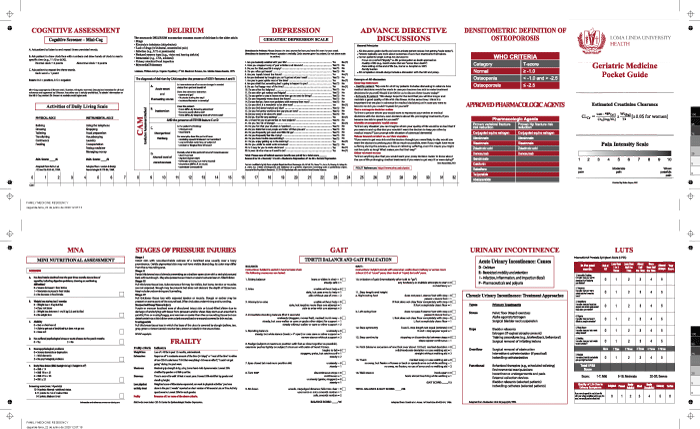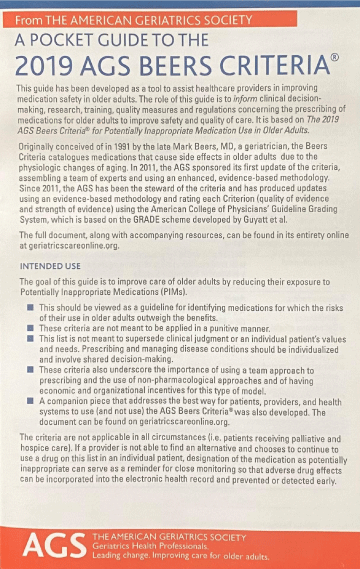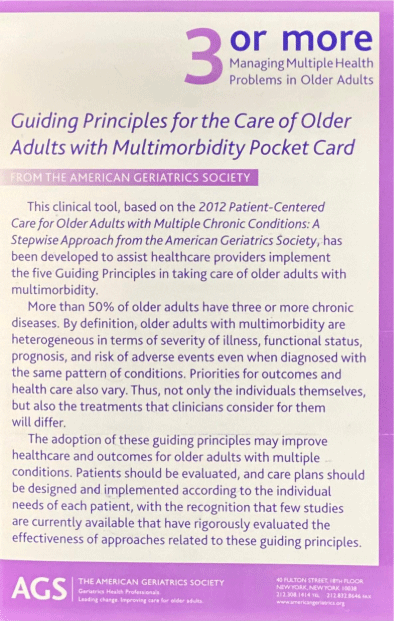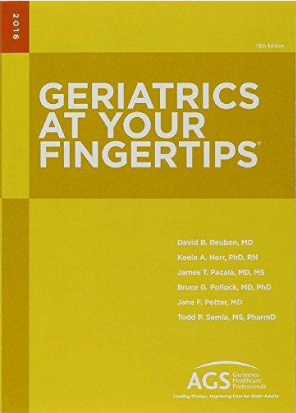
Research Article
Gerontol Geriatr Res. 2021; 7(1): 1050.
Teaching Tools to Teach Geriatric Medicine to Family Medicine Residents
Jaqua EE*, Nguyen V, Jubran A, Park S and Wijatyk A
Department of Family Medicine, Loma Linda University Health, Loma Linda, USA
*Corresponding author: Ecler Jaqua, 1200 California Street, Suite 240, Redlands, CA 92374, USA
Received: April 13, 2021; Accepted: April 23, 2021; Published: April 30, 2021
Abstract
Objective: To determine if pocket-sized, reference guides are helpful tools for teaching geriatric medicine to family medicine residents.
Setting: Loma Linda University Healthcare Education Consortium, a family medicine residency in San Bernardino County, California.
Participants: Family medicine residents that successfully completed the required geriatrics rotation between July 2019 and June 2020.
Results: From the twelve family medicine residents, 100% believed their geriatric medicine rotation helped them to be successful in residency. The preferred study tool was the pocket guides, mainly the “Geriatric Medicine Pocket Guide” and “2019 AGS Beers Criteria”. For a more comprehensive reading, the study tool most used was search engines such as Up-to-date and Dynamed. Geriatrics at Your Fingertips (Reuben et al., 2016) and the “Guiding Principles for the Care of Older Adults with Multimorbidity Pocket Card” were not as helpful due to the perceived increased efforts to rapidly find clinically relevant information.
Conclusion: Pocket guides, especially “Geriatric Medicine Pocket Guide” and “2019 AGS Beers Criteria”, are helpful teaching tools that can be used to augment geriatric medicine education in a family medicine residency.
Keywords: Geriatric; Residents; Population
Introduction
The geriatric population in the United States is projected to expand exponentially by approximately 2.3 million people per year until 2030 [1,2]. However, the current healthcare system is suspected to fall short of board-certified geriatricians to serve this growing population. Due to this anticipated shortage, it is of utmost importance to train primary care physicians to care for our geriatric community.
The care of the geriatric population is unique in that the physiology of aging can obscure acute processes, potentially delaying the diagnosis of common diseases such as pneumonia, cystitis, and myocardial infarction [3]. Moreover, age-related assessments for falls, incontinence, and neurocognitive changes need to be employed consistently to address geriatric syndromes that can affect a patient’s functionality and ability to successfully live independently. These syndromes can be more pronounced with the increased prevalence of polypharmacy [4,5]. Specific to the geriatric population, anticholinergic and sedating drugs can prove detrimental to a patient’s functionality [4,5].
With this growing geriatric population, there is an increasing need for excellent, high quality geriatric care. This need could be filled by family physicians as many reports that their practices are becoming predominantly geriatric. To ensure excellent, high quality care, geriatric medicine and its nuances should be taught at the beginning of a physician’s career, starting during primary care residency training. Currently, per the Accreditation Council for Graduate Medical Education (ACGME), family medicine residency programs require a 4-week rotation in geriatric medicine and longitudinal curriculum of nursing home custodial care in the final 2 years of residency training. Previous studies have employed interprofessional models or published resources, such as Pocket Medicine, to teach care for the geriatric population [6].
This is a quality improvement study, focused on developing geriatric medicine proficiency for the family medicine resident physicians of the Loma Linda University Healthcare Education Consortium. This study aims to standardize, and evaluate the efficacy, of geriatric medicine education using 3 pocket cards and a book as its main teaching modalities.
Methods
The ACGME-required rotation is 4 weeks long, incorporating a mix of outpatient, general geriatrics and coordination of care with trauma and orthopedic surgery at the skilled nursing facilities. Also, the family medicine resident physicians participated in the care of geriatric patients in a longitudinal nursing home curriculum with board-certified geriatricians.
At the start of the geriatric medicine rotation, each resident received 3 pocket cards and a book for formal reference throughout the rotation.
• “Geriatric Medicine Pocket Guide” (Figure 1) was created by LLUH Geriatric Medicine Division and costs $5.00 each to print and laminate. It focused on age-related assessments of geriatric syndromes such as falls and incontinence.

Figure 1: Geriatric Medicine Pocket Guide.
• “A Pocket Guide to the 2019 AGS (American Geriatric Society) Beers Criteria” (Figure 2) was created by the American Geriatric Society and costs $5.99 each for AGS members. It focused on addressing polypharmacy amongst the geriatric population.

Figure 2: AGS Beers Criteria.
• “Guiding Principles for the Care of Older Adults with Multimorbidity Pocket Card” (Figure 3) was created by the American Geriatric Society and costs $20.00 for 25 cards for AGS members. It focused on improving the care of patients with multiple comorbidities.

Figure 3: AGS Multimorbidity Pocket Card.
• Geriatrics at Your Fingertips by Rueben et al. (2016) was also distributed to the residents (Figure 4). The UCLA/West LA VA Geriatric Medicine Fellowship Program donated these books. This book was meant to provide resident physicians with a vetted, evidence-based reference for geriatric medicine.

Figure 4: Geriatrics at your Fingertips.
After the 4-week geriatric medicine rotation between July 2019 and June 2020, a cross-sectional questionnaire, consisting of 6 questions, was administered to the 12-family medicine resident physicians of LLUHEC via an online platform to evaluate the efficacy After the 4-week geriatric medicine rotation between July 2019 and June 2020, a cross-sectional questionnaire, consisting of 6 questions, was administered to the 12-family medicine resident physicians of LLUHEC via an online platform to evaluate the efficacy of the aforementioned teaching tools. The survey response was 100% (N=12) (Table 1).
1. Do you feel that preclinical training in geriatrics is adequate for clinical rotations?
2. Do you feel that clinical rotation training in geriatrics has prepared you to be successful for residency?
3. What is your preferred form of reference during a busy clinic?
4. Will the point-of-care reference documents given to you during your rotation help you on clinical rotations?
5. What geriatric topics/syndromes would be the most helpful to include in point-of-care reference documents such as the pocket guides and book that were distributed?
6. Please write a specific example of helpful information you found in any of the educational resources given to you in the beginning of the geriatric medicine rotation (Geriatric Medicine Pocket Guide, A Pocket Guide to the 2019 AGS Beers Criteria, Guiding Principles for the Care of Older Adults with Multimorbidity Pocket Card and/or Geriatrics at Your Fingertips” book by Reuben et al., 2016).
Table 1: Questionnaire.
Results
The cross-sectional survey, N=12, had a 100% completion rate. 30% of resident physicians felt that training in geriatrics, prior to the start of residency, was adequate, improved to 100% of the participants felt that the education received during the geriatrics medicine rotation prepared them to provide excellent, high-quality care for the older patient.
In a busy, primary care setting, the pocket cards were the most helpful reference. The most important topics, as cited by the resident physicians that should be included in any reference document were osteoporosis, dementia/delirium assessment, gait assessment, and polypharmacy. The “Geriatric Medicine Pocket Guide” and “2019 AGS Beers Criteria” pocket cards addressed these topics. Thus, with an N=12, 100% of the participants found these two-pocket card references as the most helpful resource provided during the rotation. The “Guiding Principles for the Care of Older Adults with Multimorbidity Pocket Card” was not used due to its complicated format hindering rapid information acquisition. Evidence-based, online search engines, such as Up-to-Date and Dynamed, were preferred over the Geriatrics at Your Fingertips textbook [7]. Also, participants were asked to describe their use of the provided education material. Their responses are noted in Table 2.
1. When I was on inpatient service this past year, I had an elderly gentleman with DM II whose son I had been speaking with and giving up dates to over the course of the admission. He had expressed concern that his father had been losing his memory recently and he would like him to be evaluated. I used my Geriatric Medicine Pocket Guide to do a screener using the Mini Cog to assess his memory.
2. I used the Geriatric Medicine Pocket Guide to go over ADLs (activities of daily living) and IADLs (instrumental activities of daily living) with a patient’s family member.
3. While the Pocket Guide and Beers Criteria handouts were convenient resources for geriatric assessments and drug therapy, the Guiding Principles for the Care of Older Adults with Multimorbidity Pocket Card was difficult to navigate. I think incorporating dedicated time at the beginning of the rotation to review the handouts would be useful to know understand how to use the handouts.
4. I have referenced the Beers Criteria pocket guide when performing medications reconciliation for clinic patients who have an extensive medication list.
5. 72-year-old female with osteoporosis. I referenced the Geriatric Medicine Pocket Guide to look for treatment options.
6. Beers criteria pocket guide was very useful when I was doing medication reconciliation in both outpatient and inpatient settings.
7. I used the Geriatric Medicine Pocket Guide to how to do a fall assessment. The Guiding Principles for the Care of Older Adults with Multimorbidity Pocket Card” didn’t have pertinent information for my clinic patients and was difficult to find answers quickly.
8. I referenced many times my Beers criteria pocket guide when I was not sure which sleeping pills I could use for my older adult patients. I found it difficult to use the multimorbidity pocket card because there are not too many useful/quick resources.
9. Geriatric Medicine Pocket Guide to refresh my memory of how to do a mini cog (cognitive initial assessment).
10. I used the Geriatric Medicine Pocket Guide to ask my patient about his ADLs and IADLs.
11. The Beers criteria pocket guide is very practical tool when I am not sure what medications I can use for my older adult patients. I had a patient with depression and the pocket guide helped me to choose the best antidepressant with the correct dosage for my older adult patient.
12. I had a patient with confusion, so it was very quick to get my Geriatric Medicine Pocket Guide and do the CAM (confusion assessment method) assessment for possible delirium.
Table 2: Examples of Clinical Scenarios where the residents used the Educational Resources.
Discussion
Due to the variable geriatric medicine training in medical school, this study confirmed the importance of having a dedicated geriatric medicine education early in a primary care physicians’ training. The breadth of primary care, specifically family medicine, needs current, evidence-based, cost effective, and efficient resources for the competent care of the vulnerable geriatric population [8].
Quick references, such as the “Geriatric Medicine Pocket Guide” and “2019 AGS Beers Criteria” were preferred over textbooks due to their easy readability and accessibility in clinic. However, it is also important to recognize that these pocket cards can be overwhelming due to its condensed format. The usability of these cards is dependent on an already strong foundation in geriatric medicine. Online databases, such as Up-to-Date and Dynamed, were also preferred due to their availability in multiple clinical settings. The ideal set of references for this technology-driven generation of medical professionals is preferably available via the internet, smartphone compatible, and has a user-friendly application [9].
Geriatric medicine resources can be distributed to learners and will help, but the future lies within integrating traditional learning approaches, i.e., books and databases, with more technology-centric modalities. Technology-centric modalities have the potential to be cost effective, efficient, and user-friendly, making the family medicine physician more equipped to care for the geriatric population [10]. Thus, a potential study to help identify and create these technologycentric modalities in the care for the older adult, in a busy clinic, would be beneficial.
Conclusion
The United States of America has a growing geriatric population, anticipated to outnumber the pediatric population by 2030 [2]. This vulnerable population, one that will overwhelm the current healthcare system, will need competent and compassionate healthcare. Primary care physicians can help fill this need but, first, will need adequate geriatric medicine training, starting early in their careers. Using pocket cards, such as the “Geriatric Medicine Pocket Guide” and “2019 AGS Beers Criteria”, is helpful and can be used as a teaching tool to create the foundation for the family medicine physician’s care of the older adult. Unfortunately, more condensed resources such as textbooks are no longer helpful and practical. The future in teaching geriatric medicine may lie in technology and needs to be explored.
References
- The United States Census Bureau. The Next Four Decades: The Older Population in the United States: 2010 to 2050. 2010.
- The United States Census Bureau. Older People Projected to Outnumber Children. 2018.
- Rich MW. Epidemiology, Clinical Features, and Prognosis of Acute Myocardial Infarction in the Elderly. The American Journal of Geriatric Cardiology. 2006; 15: 7-13.
- Nam Y, Han JS, Kim JY, Bae WK & Lee K. Prescription of potentially inappropriate medication in Korean older adults based on 2012 Beers Criteria: A cross-sectional population-based study. BMC Geriatrics. 2016; 16: 118.
- Mecca MC, Thomas JM, Niehoff KM, Hyson A, Jeffery SM, Sellinger J, et al. Assessing an Interprofessional Polypharmacy and Deprescribing Educational Intervention for Primary Care Post-graduate Trainees: A Quantitative and Qualitative Evaluation. Journal of General Internal Medicine. 2019; 34: 1220- 1227.
- Brown MM, Halpert K, Dale M, Helton M & Warshaw G. Advanced Geriatrics Evaluation Skills. Family Medicine. 2020; 52: 206-208.
- Reuben DB, Herr KA, Pacala JT, Potter JF & Semla TP. Geriatrics at your fingertips (18th ed.). New York, NY: American Geriatrics Society. 2016.
- Nakagawa K & Yellowlees P. Inter-generational Effects of Technology: Why Millennial Physicians May Be Less at Risk for Burnout Than Baby Boomers. Current Psychiatry Reports. 2020; 22: 45.
- Boysen P, Daste L & Nothern T. Multigenerational Challenges and the Future of Graduate Medical Education. Ochsner J. 2016; 16: 101-107.
- Moriarty JP, Wu BJ, Blake E, Ramsey CM, Kumar C, Huot S, et al. Assessing Resident Attitudes and Confidence after Integrating Geriatric Education Into a Primary Care Resident Clinic. The American Journal of Medicine. 2018; 131: 709-713.